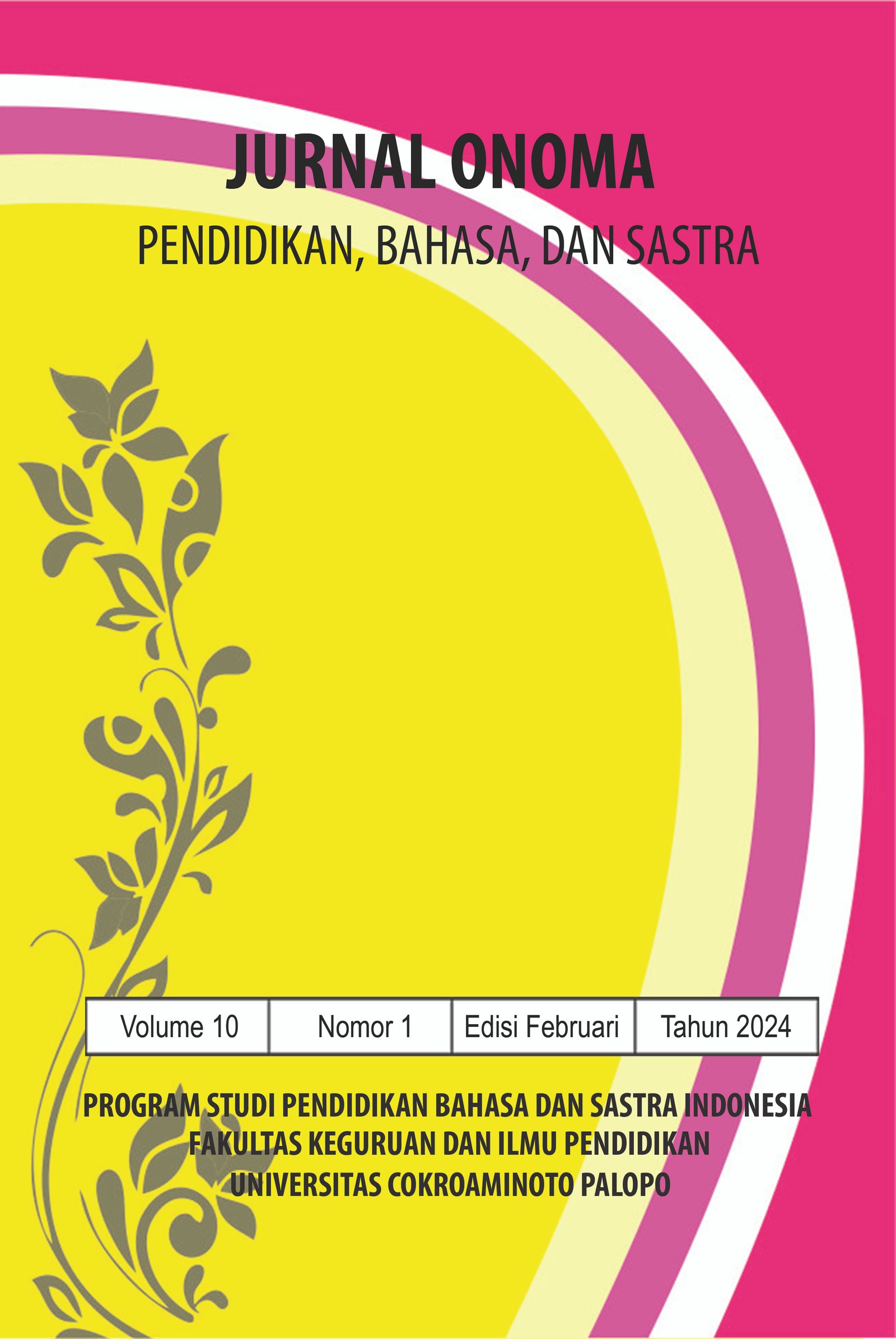Analisis Enklitik Bahasa Makassar sebagai Penanda Aspek
https://doi.org/10.30605/onoma.v10i1.3420
Keywords:
Bahasa Makassar, Enklitik, Linguistik, Penanda AspekAbstract
Penelitian ini membahas tentang penggunaan enklitik dalam bahasa Makassar sebagai penanda aspek dalam kalimat. Enklitik adalah elemen linguistik yang memiliki peran penting dalam menyampaikan informasi tentang durasi, kesudahan, atau kelanjutan suatu tindakan dalam kalimat. Penelitian ini menggunakan metode deskriptif dengan mengumpulkan data dari bahasa Makassar, terutama kalimat-kalimat yang menggunakan enklitik sebagai penanda aspek. Hasil penelitian tersebut menyimpulkan bahwa dalam bahasa Makassar, enklitik memiliki peran khusus sebagai penanda aspek dalam kalimat. Ketika frasa verba diberi enklitik -mi frasa tersebut menandakan aspek duratif (sedang berlangsung), ketika diberi enklitik -ji frasa tersebut tidak memiliki penanda aspek, dan ketika diberi enklitik -pi frasa tersebut menandakan aspek futuristik (akan terjadi di masa depan). Ketika enklitik digabungkan dengan frasa nomina, frasa tersebut tidak memiliki penanda aspek jika diberi enklitik –mi atau -ji tetapi memiliki penanda aspek futuristik jika diberi enklitik –pi. Sementara itu, pada frasa adjektiva, jika diberi enklitik -mi frasa tersebut menandakan aspek perfektif (telah selesai), jika diberi enklitik -ji frasa tersebut tidak memiliki penanda aspek, dan jika diberi enklitik -pi frasa tersebut menandakan aspek futuristik. Penelitian ini memberikan pemahaman yang mendalam tentang peran enklitik dalam bahasa Makassar sebagai penanda aspek, serta memperkaya pengetahuan dalam bidang linguistik. Penggunaan enklitik dengan penanda aspek yang berbeda memberikan nuansa khusus dalam berkomunikasi dalam bahasa tersebut
Downloads
References
Amir, J., & Dalle, A. (2017). Klitika Dalam Bahasa Makassar Dan Dampaknya Terhadap Penggunaan Bahasa Indonesia. Prosiding Kolita 15.
Anita, R. (2016). Hojodoushi -Teiru Dan –Tearu Sebagai Penanda Aspek Resultatif Dalam Kalimat Bahasa JepanG 結果相を表す補助動詞「~ている」と「~てある」. Universitas Diponegoro.
Aor, T. (2021). JFP Publishers | Academic Voices ( AV ) Analysis of Tiv clitics. JFP Publisher Academic Voices (AV), 1989, 14–17.
Ariyadi, A. D., & Utomo, A. P. Y. (2020). Analisis Kesalahan Sintaksis pada Teks Berita Daring berjudul Mencari Etika Elite Politik di Saat Covid-19. Jurnal Baahasa Dan Sastra, 8(3), 138–145. https://doi.org/10.24036//jbs.v8i3.110903 DOI: https://doi.org/10.24036/jbs.v8i3.110903
Boudchiche, M., Mazroui, A., Ould Abdallahi Ould Bebah, M., Lakhouaja, A., & Boudlal, A. (2017). AlKhalil Morpho Sys 2: A robust Arabic morpho-syntactic analyzer. Journal of King Saud University - Computer and Information Sciences, 29(2), 141–146. https://doi.org/10.1016/j.jksuci.2016.05.002 DOI: https://doi.org/10.1016/j.jksuci.2016.05.002
Dewi, R., Ariyani, F., & Rusminto, N. E. (2023). Pemertahanan Bahasa Lampung Dalam Ranah Pendidikan. Jurnal.Fkip.Unila.Ac.Id, 3(1), 48–56. https://doi.org/http://dx.doi.org/10.23960/Tiyuh DOI: https://doi.org/10.23960/Tiyuh
Eliastuti, M., Meliana, M., & Hadi, S. (2023). Peranan Sintaksis Bagi Siswa Sekolah Dasar | Jurnal Pendidikan Dasar dan Sosial Humaniora. Jurnal Pendidikan Dasar Dan Sosial Humaniora, 2(7), 725–732.
Fadhilah, A. N., & Rahmawati, L. E. (2020). Penggunaan Bahasa Daerah pada Buku Bacaan Siswa Terbitan Kemdikbud. Linguista: Jurnal Ilmiah Bahasa, Sastra, Dan Pembelajarannya, 4(1), 43–50. https://doi.org/10.25273/LINGUISTA.V4I1.6457 DOI: https://doi.org/10.25273/linguista.v4i1.6457
Fauzia, A., Hamdani, F., Yomi, A., M, M. A. M., Satriawan, R., & Mernissi, Z. (2022). Upaya Peningkatan Bahasa Sehat di Tengah Dekadensi Bahasa Indonesia melalui Integrasi Kurikulum Pendidikan dan Kampus Merdeka. Indonesia Berdaya, 3(3), 681–690. https://doi.org/10.47679/IB.2022289 DOI: https://doi.org/10.47679/ib.2022289
Helmbrecht, J. (2018). Siouan and Caddoan Editor. Proceedings of the 38th Siouan and Caddoan Languages Conference.
Ivanová, M., Kyseľová, M., & Gálisová, A. (2021). Acquiring Word Order in Slovak as a Foreign Language: Comparison of Slavic and Non-Slavic Learners Utilizing Corpus Data. Jazykovedny Casopis, 72(2), 353–370. https://doi.org/10.2478/jazcas-2021-0033 DOI: https://doi.org/10.2478/jazcas-2021-0033
Mangga, S. (2016). Klitika dalam Klausa Pasif Bahasa Manggarai. Linguistik Indonesia, Februari, 34(1), 57–66. https://www.linguistik-indonesia.org/images/files/g) Klitika dalam Klausa Pasif Bahasa Manggarai.pdf DOI: https://doi.org/10.26499/li.v34i1.41
Marliana, M. A., Agustina, A., & Ngusman, N. (2018). Adverbia Penanda Aspek Dalam Novel Negeri 5 Menara Karya Ahmad Fuadi. Jurnal Bahasa Dan Sastra, 5(2), 1–8. DOI: https://doi.org/10.24036/896210
Rasdana, O., & Asnawi, A. (2023). Studi Klitika dalam Bahasa Banjar Hulu Kabupaten Indragiri Hilir. GERAM, 11(1), 137–145. https://doi.org/10.25299/GERAM.2023.VOL11(1).12169 DOI: https://doi.org/10.25299/geram.2023.vol11(1).12169
SARNILA, S. (2022). Interferensi Dan Integrasi Bahasa Makassar Dengan Bahasa Indonesia Di Kalangan Masyarakat Kepulauan [Universitas Muhammadiyah Makassar]. In digilibadmin.unismuh.ac.id. https://digilibadmin.unismuh.ac.id/upload/32834-Full_Text.pdf
Sudiyono, S., Priyadi, A. T., & Salem, L. (2019). Stilistika Dalam Novel Para Priyayi Karya Umar Kayam. Jurnal Pendidikan Dan Pembelajara Khatulistiwa, 8(10), 1–9. https://jurnal.untan.ac.id/index.php/jpdpb/article/view/36201
Taghipour, S., & Kahnemuyipour, A. (2021). Agreement with Deficient Pronouns in Laki : A Syntactic Repair to a Clitic Cluster Restriction. Proceedings of the 38th West Coast Conference on Formal Linguistics, 417–426.
Wahidah, B. Y. kurnia. (2019). Analisis Bentuk Klitika Dalam Bahasa Sasak. JUPE : Jurnal Pendidikan Mandala, 5(5). https://doi.org/10.58258/JUPE.V5I5.1298 DOI: https://doi.org/10.58258/jupe.v5i5.1298
Downloads
Published
How to Cite
License
In submitting the manuscript to the journal, the authors certify that:
- They are authorized by their co-authors to enter into these arrangements.
- The work described has not been formally published before, except in the form of an abstract or as part of a published lecture, review, thesis, or overlay journal.
- That it is not under consideration for publication elsewhere,
- That its publication has been approved by all the author(s) and by the responsible authorities – tacitly or explicitly – of the institutes where the work has been carried out.
- They secure the right to reproduce any material that has already been published or copyrighted elsewhere.
- They agree to the following license and copyright agreement.
License and Copyright Agreement
Authors who publish with Onoma Journal: Education, Languages??, and Literature agree to the following terms:
- Authors retain copyright and grant the journal right of first publication with the work simultaneously licensed under Creative Commons Attribution License (CC BY 4.0) that allows others to share the work with an acknowledgment of the work's authorship and initial publication in this journal.
- Authors are able to enter into separate, additional contractual arrangements for the non-exclusive distribution of the journal's published version of the work (e.g., post it to an institutional repository or publish it in a book), with an acknowledgment of its initial publication in this journal.
- Authors are permitted and encouraged to post their work online (e.g., in institutional repositories or on their website) prior to and during the submission process, as it can lead to productive exchanges, as well as earlier and greater citation of published work.

















